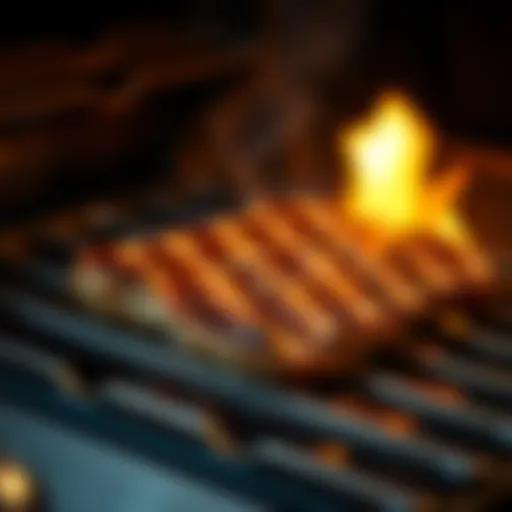Essential Techniques for Metal Sash Window Repair
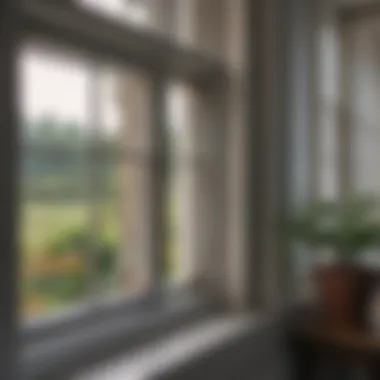

Intro
Metal sash windows hold a unique charm in both historical and modern architecture. Their intricate design combines functionality with aesthetics, making them a desired feature in many homes. These windows are not just functional barriers against the elements; they also contribute significantly to the character of a building. As with any home feature, metal sash windows require maintenance and, at times, repairs to ensure their durability and visual appeal.
This guide aims to equip homeowners and restoration enthusiasts with a comprehensive understanding of the repair process for metal sash windows. We will delve into the components of these windows, identify common issues faced, and explore practical repair techniques. By understanding the historical significance and contemporary relevance of metal sash windows, readers can appreciate their value even more.
The goal of this article is to foster confidence in tackling repair tasks, helping maintain both the functionality and the aesthetic appeal of living spaces.
Understanding Metal Sash Windows
Metal sash windows are integral to many architectural designs, serving both functional and aesthetic roles. Understanding these windows is vital for homeowners and restoration enthusiasts who wish to maintain or enhance the historic integrity of their properties. These windows are known for their durability, elegance, and ability to withstand diverse weather conditions. By comprehending their construction, historical context, and material usage, one can effectively address common issues that may arise, ensuring longevity and optimal performance.
Historical Context
Metal sash windows emerged during the 19th century, rapidly gaining popularity in urban buildings. This design allowed for larger panes of glass and improved ventilation. Initially, these windows were designed to be both practical and visually appealing, reflecting the architectural trends of the time. Over decades, metal sash windows became synonymous with both commercial and residential structures, marking significant historical periods in architecture. Their enduring presence in building environments highlights their effectiveness and reliability.
Architectural Significance
In terms of architectural significance, metal sash windows contribute greatly to a building’s visual character and historical value. Often found in Victorian, Edwardian, and Art Deco buildings, these windows encapsulate specific design aesthetics and manufacturing techniques of their eras. They allow natural light to penetrate deeper into spaces, creating brighter and more inviting interiors. From a restoration perspective, retaining original metal sash windows plays a crucial role in maintaining the overall architectural narrative of a property.
Common Materials Used
Metal sash windows are primarily constructed from various materials that contribute to their strength and longevity:
- Steel: Most traditional metal sash windows are made from steel due to its strength and durability. Steel allows for the creation of thinner frames, maximizing the glass area.
- Aluminum: This material offers excellent resistance to corrosion and requires minimal maintenance. Aluminum is lightweight and provides good thermal efficiency when treated correctly.
- Zinc: Sometimes used for decorative aspects, zinc can enhance a window's appearance while providing additional protection against the elements.
Understanding these materials is essential when considering repairs or replacements. Each material presents distinct challenges and advantages that impact maintenance strategies and restoration choices. The right knowledge can lead to informed decisions that will underpin the quality and performance of your metal sash windows.
Typical Issues with Metal Sash Windows
Addressing typical issues with metal sash windows is crucial for maintaining their functionality and aesthetic appeal. Understanding these problems is the foundation for effective repair strategies. Ignoring signs of wear and tear can lead to more extensive damage and costly repairs. As metal sash windows age, they confront various challenges. Recognizing these common issues ensures homeowners can implement timely interventions to extend the life of their windows. Moreover, being proactive about repairs enhances overall energy efficiency and contributes to the preservation of architectural integrity.
Rust and Corrosion
Rust and corrosion are prevalent concerns for metal sash windows. These elements are particularly susceptible to deterioration due to environmental factors. Exposure to moisture and humidity often leads to rust formation, which compromises the structural integrity of the frame. Corrosion may also spread rapidly if not addressed quickly, resulting in holes and structural weakness.
To tackle rust effectively, homeowners should perform regular inspections. Look for any signs of flaking or discoloration. If rust is found, it can be remedied by sanding the affected area and using a rust-inhibiting primer. Following this, applying a protective paint will safeguard the metal from future corrosion. Using weatherproof paint enhances durability and improves overall appearance.
Weather Stripping Deterioration
Weather stripping plays a vital role in sealing metal sash windows. Over time, this material degrades due to constant exposure to the elements. Deterioration can cause drafts, increase energy costs, and allow moisture to seep into the interior. Therefore, checking the condition of the weather stripping is essential for maintaining thermal efficiency.
Replacement is often necessary if the weather stripping is cracked or brittle. Homeowners can easily address this issue by purchasing the right type of weather stripping material. Self-adhesive strips are an effective choice, allowing for straightforward installation without significant tools or expertise required. Ensuring a tight seal will not only enhance comfort but also protect against potential water damage.
Frame Distortion
Frame distortion in metal sash windows is another common issue. It can occur due to prolonged exposure to heat or cold. Over time, the frame may warp, leading to misalignment in the window sashes. Misalignment can hinder their ability to open and close smoothly, which is both inconvenient and can worsen structural issues.
Homeowners should inspect their windows for any signs of frame distortion, such as gaps between the sash and frame. Realignment may be possible through simple adjustments. However, in severe cases, replacing warped sections might be necessary. Utilizing proper maintenance routines can help prevent distortion from occurring in the first place.
Glass Panes Issues
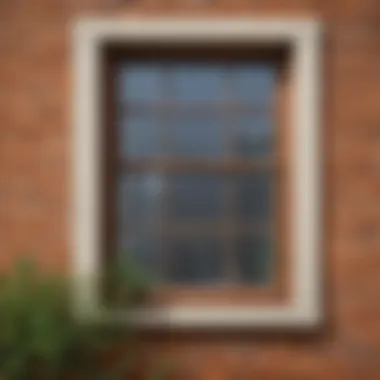

Problems related to glass panes can manifest as cracks, fogging, or even complete breakage. Various factors contribute to these issues, including temperature fluctuations and physical impact. Such damage not only affects functionality but also compromises the aesthetic aspect of metal sash windows.
For minor cracks, repairs can sometimes be done with clear epoxy or specialized glass adhesives. However, if the damage is extensive, replacing the glass should be considered. Utilizing double-glazed panes can provide better insulation since they help regulate temperature. This choice contributes to the energy efficiency of the home while maintaining the historical character of the windows.
Maintaining awareness of these typical issues is essential. Regular attention to rust, weather stripping, frame condition, and glass panes can prevent costly repairs in the future.
Assessment Before Repair
Before embarking on the journey of repairing metal sash windows, it is essential to conduct a thorough assessment. This phase is crucial for understanding the condition of the windows and determining the necessary steps for repair. Not only does it help in identifying the issues at hand, but it also offers insight into whether one should pursue repair or consider a full replacement. An accurate assessment can save both time and money, making it a foundational step in the repair process.
Visual Inspection Techniques
Regular visual inspections can reveal a wide array of issues with metal sash windows. Homeowners should start by looking for visible rust or corrosion on the surface of the metal. Check for discoloration or flaking paint, which can indicate underlying damage. Use a flashlight to inspect the corners, joints, and areas where water accumulates.
Other signs to look for include:
- Deterioration of the weather stripping.
- Gaps or misalignment in the window frame.
- Presence of moisture between glass panes, suggesting seal failure.
Taking notes during these inspections helps track the condition over time. A visual log can assist in making informed decisions later.
Determining Repair vs Replacement
Once a visual assessment concludes the existence of damage, the next significant decision is whether to repair or replace parts of the metal sash window. This choice hinges on several factors including the extent of damage, budget, and the overall goals of the homeowner.
- Extent of Damage: Minor rust may only require scraping and repainting, whereas severe corrosion could mean the entire frame needs replacing.
- Historical Value: If preserving historical features is important, repairs may be preferable to maintain authenticity.
- Cost Considerations: Evaluate the repair costs against the potential expenses of full replacement. Sometimes, repairing is more cost-effective.
This analysis is vital to ensure that repairs contribute positively to the window’s functionality and longevity.
Identifying Structural Weaknesses
Understanding the structural integrity of metal sash windows is pivotal in the assessment phase. Structural weaknesses can lead to larger problems if left unattended. Homeowners should look for signs such as bending in the frames, loose joints, or gaps in the seals. These weaknesses can compromise the window's functionality and security.
To thoroughly assess structural weaknesses:
- Walk around the window and test its stability by gently pushing on the frames.
- Check for any irregular operational issues when opening or closing the window.
- Use a level to ensure that the sash itself is straight and not leaning.
By identifying these weaknesses early on, homeowners can address repairs proactively, ensuring their metal sash windows remain robust and reliable.
"A comprehensive assessment not only highlights current issues but can also prevent future repairs by addressing weaknesses early."
In summary, the assessment stage is critical for setting the stage for effective repairs. It provides the foundation needed to make informed decisions that improve the longevity and overall appearance of metal sash windows.
Essential Tools and Materials for Repair
Repairing metal sash windows requires specific tools and materials. The right equipment not only enhances efficiency during the repair process but also ensures that the work maintains high quality. Understanding what is needed helps the repair journey to go smoothly, allowing the repair to be done correctly and with confidence.
List of Tools Required
When preparing for a metal sash window repair, having the right tools on hand is essential. Here is a list of commonly required tools:
- Screwdrivers: Both flathead and Phillips screwdrivers are necessary. These are needed for removing and attaching window components.
- Pliers: A good pair of pliers helps in grasping and bending metal parts. Needle-nose pliers are particularly useful for tight spots.
- Hacksaw: This is used for cutting metal, especially when frame repair or modification is needed.
- Wire Brush: To remove rust and debris, a wire brush is very helpful. It cleans surfaces effectively, preparing them for further treatment.
- Drill: A power drill is essential for making holes for screws or anchors. It speeds up the process.
- Putty Knife: This is important for applying or removing caulk or sealants.
- Measuring Tape: Accurate measurements are vital. A measuring tape helps in fitting new glass panes or components precisely.
- Safety Gear: Always include safety glasses and gloves to protect against sharp edges and debris during repair work.
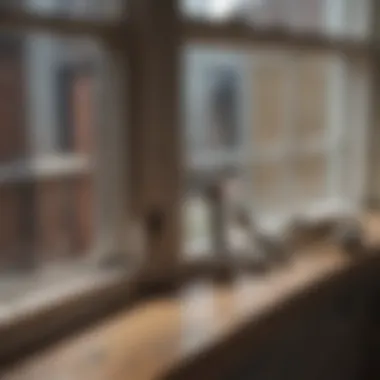

Recommended Repair Materials
Alongside tools, selecting the right materials for repairs is crucial. Here are some materials that are often recommended for working on metal sash windows:
- Rust Inhibitor Paint: This helps protect against future rust and corrosion. It is especially useful in areas with high moisture.
- Weather Stripping Material: Options such as rubber or foam weather stripping will aid in improving insulation and preventing drafts.
- Silicone Sealant: This is essential for sealing gaps, especially around glass panes. It provides protection against water intrusion.
- Glass Repair Kits: These kits typically include resin and hardener. They are useful for minor glass repairs and chips.
- Metal Filler: When dealing with rust damage, metal filler helps to repair small holes or pitting in the metal frame.
- Replacement Glass: In cases where glass is broken, sourcing suitable replacement glass is necessary. Ensure it matches the original dimensions.
"Having the correct tools and materials is half the battle in repair; it sets the stage for success."
By preparing adequately with both tools and materials, homeowners can tackle repairs to metal sash windows effectively. Proper selection leads to improved durability. This preparation ensures that both the repair process and the finished results will meet the standards expected in metal sash window care.
Repair Procedure for Metal Sash Windows
When it comes to maintaining the beauty and functionality of metal sash windows, a systematic approach to repair is crucial. Understanding each step ensures not only the structural integrity of the window but also enhances the overall aesthetic of the property. In this section, we will focus on practical procedures that homeowners can undertake, offering insights into the importance of each repair process and how it contributes to the longevity of these architectural elements.
Preparing the Workspace
Before starting any repair, it is essential to prepare the workspace. A tidy area minimizes distractions and helps in managing tools and materials efficiently. Follow these steps to prepare:
- Clear the Area: Remove any furniture or obstacles around the windows to have a safe and open working space.
- Gather Tools and Materials: Ensure all necessary items are within reach, including tools like screwdrivers, pliers, and safety glasses. Having a dedicated storage for materials also saves time.
- Protect Your Space: Lay down drop cloths or old sheets to catch dust and debris. This preserves the area where you are working and facilitates easier clean-up after repairs.
Addressing Rust and Corrosion
Rust and corrosion are significant issues that can lead to further damage if left untreated. In this process, the focus is on identifying affected areas and restoring the metal's integrity. To effectively address rust and corrosion, consider the following:
- Inspection: Check the entire frame for signs of rust. This can appear as orange or brown spots on the metal surface.
- Cleaning: Use a wire brush or sandpaper to remove loose rust. For tougher areas, a chemical rust remover like Ospho may be needed. This helps to expose clean metal for better repair.
- Protective Coating: After cleaning, apply a rust-inhibiting primer. This layer protects against future oxidation and further corrosion.
Replacing Weather Stripping
Weather stripping is crucial for maintaining energy efficiency and comfort in your home. Over time, it can wear out or become brittle, leading to drafts. To replace weather stripping:
- Examine Existing Stripping: Check for gaps or deformations that indicate the need for replacement.
- Remove Old Stripping: Carefully peel away the old weather stripping, ensuring that the surface is clean for new application.
- Install New Stripping: Measure and cut the new weather stripping to fit perfectly, then press it firmly against the frame. Use types suitable for metal, like V-strip or adhesive foam, for better adhesion and longevity.
Fixing Frame Distortion
Frame distortion can occur due to various factors, including age and weather conditions. This affects the window's functionality and appearance. Follow these steps to rectify frame distortion:
- Assessment: Identify areas where the frame is not aligned correctly. This may require a level to ensure proper alignment.
- Adjusting the Frame: Use shims to make necessary adjustments. Insert them at points where the frame does not fit snugly.
- Reinforce Weak Areas: If sections of the frame are weak, reinforce them with angles or braces where needed.
Repairing or Replacing Glass Panes
Glass panes in metal sash windows may need repair or replacement due to cracks or breakage. When addressing glass issues, keep in mind:
- Safety First: Wear protective gloves and eyewear to safeguard against injury.
- Removing Damaged Glass: Carefully remove any broken glass pieces using a putty knife or similar tool. Take care not to damage the frame in the process.
- Replacement: Measure for new glass. Purchase glass cut to fit or if replacing larger sections, consider tempered safety glass for durability. Secure it with glazing points and putty for a tight seal.
Finale
By following these step-by-step procedures, homeowners can address the most common issues faced during metal sash window repairs. Each task—preparing the workspace, addressing rust, replacing weather stripping, fixing distortions, and handling glass panes—plays a vital role in sustaining the functionality and beauty of these architectural features.
Undertaking these repairs not only enhances the lifespan of your windows but also preserves the historical value they contribute to your home.
Finishing Touches
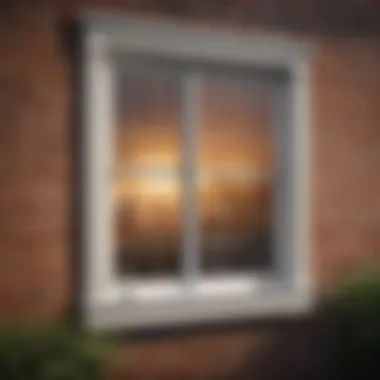

Finishing touches play a critical role in the repair and restoration of metal sash windows. These steps not only elevate the overall aesthetics of the windows but also ensure longevity. Proper finishing can protect against future damage, enhancing not just the visual appeal but also the functionality of the windows. Whether you are preparing for a seasonal change or simply maintaining your home’s appearance, these tasks are key.
Painting and Refinishing Options
When considering painting and refinishing options, selecting the right materials is essential. Metal sash windows can benefit greatly from a fresh coat of paint, which can act as a protective barrier against moisture and rust. When choosing paint, opt for products that are specifically designed for metal surfaces, as they adhere better and provide longer-lasting results.
- Preparation: Start by thoroughly cleaning the window frame to remove dirt, old paint, or rust. Sand the surface lightly to ensure a key for the new paint. Make sure you use a primer meant for metal surfaces; this will help with adhesion and durability.
- Type of Paint: Consider using acrylic or oil-based paints. Acrylic paints are easier to clean up and dry faster, while oil-based paints can provide a tougher finish. Both types should have rust-inhibiting properties for added protection.
- Application Methods: You can apply paint using a brush or spray method. Brushing allows for more control and precision, while spraying can cover large areas more quickly. Whichever method you choose, consider applying multiple thin coats rather than one thick coat for better coverage.
- Finishing Seal: After the final coat of paint, consider applying a clear sealant. This adds an extra layer of protection against the elements and wear, prolonging the life of your window finish.
Final Cleaning Procedures
Once the painting is complete, final cleaning is vital to ensure that your metal sash windows look pristine. This part of the process can often be overlooked, but it has significant impact on both appearance and maintenance.
- Cleaning Solutions: Use mild soap and water or a glass cleaner that is safe for metal. Avoid harsh chemicals, as they can corrode the paint or attract dirt.
- Cleaning Tools: Use soft cloths or sponges for washing. Avoid abrasive materials that could scratch the surface. A microfiber cloth is ideal for achieving a streak-free finish on glass panes.
- Addressing Remaining Debris: Inspect for any dust or paint splatters on the glass. A thorough wipe-down will ensure clarity and enhance natural light within living spaces.
- Routine Maintenance: Regularly clean the window frames and glass to prevent buildup of dirt and grime. Not only will this keep your windows looking great, but it will also help in spotting potential issues early on.
Regular maintenance ensures the longevity of your investment and keeps the architectural charm of your home intact.
Overall, investing time in these finishing touches can greatly enhance the beauty and functionality of metal sash windows. These tasks are not just superficial; they are integral to a comprehensive repair strategy.
Preventative Maintenance Tips
Preventative maintenance is essential for maintaining the integrity and aesthetic appeal of metal sash windows. Regular upkeep helps to identify potential issues before they escalate into costly repairs. Additionally, proactive measures can significantly extend the lifespan of these windows, which is particularly important for older or historically significant buildings. Effective maintenance not only preserves the functionality of the windows but also contributes to the overall energy efficiency of the home, minimizing heating and cooling costs.
Regular Inspection Schedule
Establishing a regular inspection schedule is crucial for effective preventative maintenance. Inspecting metal sash windows at least twice a year can help you catch early signs of wear. During these inspections, check for:
- Signs of rust: Look for discoloration or flaking paint.
- Weather stripping condition: Examine the seals around the windows for any cracks or deterioration.
- Frame stability: Ensure there are no warps or bends that could impact performance.
- Glass condition: Check for cracks or seals that may need replacing.
Document each inspection’s findings to track progress over time. This method allows you to address issues promptly and make informed decisions regarding repairs or replacements.
Seasonal Maintenance Considerations
Seasonal maintenance is important to prepare your metal sash windows for changing weather conditions. Different seasons present unique challenges that may affect performance. Consider these maintenance tasks:
- Spring: Clean the windows to remove dirt and debris from winter. Inspect the hardware, hinges, and other moving parts for functionality.
- Summer: Apply a protective coating against UV damage. Consider lubricating moving parts to ensure smooth operation.
- Autumn: Clear any leaves or debris to prevent blockages that can lead to moisture buildup.
- Winter: Inspect weather stripping to ensure it provides an adequate seal against cold air and moisture.
Implementing a seasonal maintenance routine will safeguard your metal sash windows against the elements and save you from extensive repairs in the future.
Epilogue
In this guide, the importance of understanding how to repair metal sash windows cannot be overstated. Maintaining these architectural features not only preserves their historical value but also enhances the overall appearance and functionality of your home. Proper repair techniques can ensure longevity and prevent further damage, which ultimately saves homeowners from costly replacements in the future.
Recap of Key Points
Several key points have been discussed throughout the article that highlight the critical aspects of metal sash window repair:
- Understanding Metal Sash Windows: We explored their historical and architectural significance, as well as the common materials used in their construction.
- Typical Issues: Common problems such as rust, corrosion, weather stripping deterioration, and frame distortion were outlined. Addressing these issues promptly can significantly extend the life of your windows.
- Assessment Before Repair: Before undertaking repairs, one must visually inspect the windows, determine if repair or replacement is necessary, and identify any structural weaknesses.
- Essential Tools and Materials: A list of necessary tools and recommended materials makes the repair process more manageable.
- Repair Procedure: Detailed procedures for addressing each issue ensure a structured approach to repairs, making the task less daunting.
- Finishing Touches: Final steps like painting, refinishing, and cleaning enhance the aesthetic appeal and protect the windows.
- Preventative Maintenance Tips: Regular inspections and seasonal maintenance help avoid future issues, ensuring the windows remain in good condition.
Encouragement for DIY Repair
Homeowners should feel empowered to undertake metal sash window repairs on their own. DIY repairs can be rewarding and financially beneficial. While the process may seem challenging at first, the steps outlined in this guide provide a clear path.
Engaging in these tasks allows homeowners to develop a deeper understanding of their living space, fostering a sense of accomplishment. Tools and materials required for repairs are widely available. With careful planning and meticulous execution, anyone can restore their metal sash windows to their former glory. Remember, even minor repairs can have a significant impact, both functionally and aesthetically.
"Repairing metal sash windows not only enhances their performance but also connects you to the rich history of your home."
With diligence and patience, the journey of restoring metal sash windows can provide long-lasting rewards, encouraging a deeper appreciation for these elegant architectural features.



